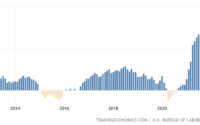Higher Vehicle, Energy Imports Push January U.S. Trade Deficit to New Record
The U.S. trade deficit hit a fresh record in January ahead of the Russia-Ukraine crisis, as imports of vehicles and energy supplies increased while exports fell.
The rise in imports reflected strength in U.S. consumer demand, said
Stephen Stanley,
chief economist at Amherst Pierpont. He added that the Russia-Ukraine crisis and strengthening U.S. dollar could push import totals higher in the months ahead.
The Biden administration is planning to ban Russian oil imports into the U.S. Sanctions on the Russian economy come at a time in which inflation and gas prices are already at multiyear highs, and further trade disruptions are likely to push prices higher still.
The widening of the deficit in January reflected a pickup in demand for foreign-made imports as businesses restocked shelves, but demand for U.S. exports weakened. In January, many businesses struggled with Omicron-related absenteeism, rising energy prices that affected distribution, and ongoing supply-chain disruptions.
Imports increased 1.2% in January, led by shipments of foreign-made vehicles, industrial supplies including crude oil and natural gas, food and capital goods like telecommunications equipment. Exports, meanwhile, fell 1.7%. Exports of consumer goods like pharmaceuticals fell, which analysts attributed to fewer shipments of Covid-19 vaccines, as did services exports like travel and transport.
Trade has been volatile in recent months. The coronavirus pandemic initially closed factories and businesses around the world and disrupted supply chains, but international trade roared back last year, repeatedly pushing the U.S. trade deficit to record levels. Still, companies have struggled with shipping backlogs, product scarcity, order cancellations and delays as a result of the ramp-up in demand.
Trade is likely to face further disruption from the conflict in Ukraine and sanctions on the Russian economy.
The U.S. imported about $29.7 billion in goods from Russia in 2021, ranking it 19th among U.S. import partners—just behind Brazil and ahead of Singapore, according to Census Bureau data. Oil products accounted for nearly 60% of the value of those imports, followed by precious metals, iron and steel, seafood and fertilizers.
On a dollar basis, Russia in 2021 was the nation’s second-largest supplier of palladium, a primary component of catalytic converters for vehicles. The U.S. imported about $1.7 billion of the metal from Russia, behind $1.9 billion from South Africa, according to Census data.
Other commodities Russia sends to the U.S. range from uranium for use in nuclear reactors to crabs, with about $1.1 billion imported in 2021.
Write to Harriet Torry at [email protected] and Anthony DeBarros at [email protected]
Copyright ©2022 Dow Jones & Company, Inc. All Rights Reserved. 87990cbe856818d5eddac44c7b1cdeb8
[ad_2]
Source link


